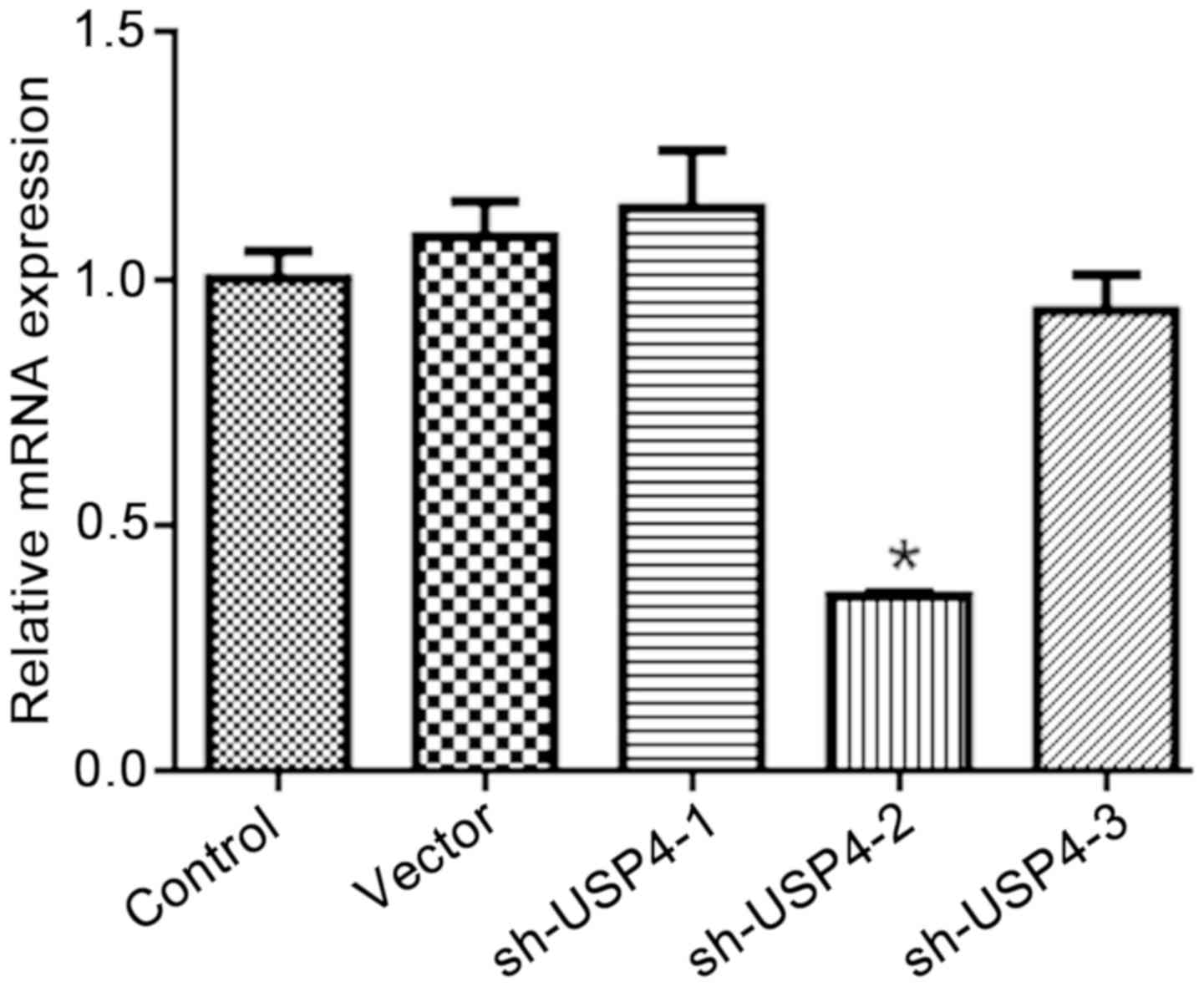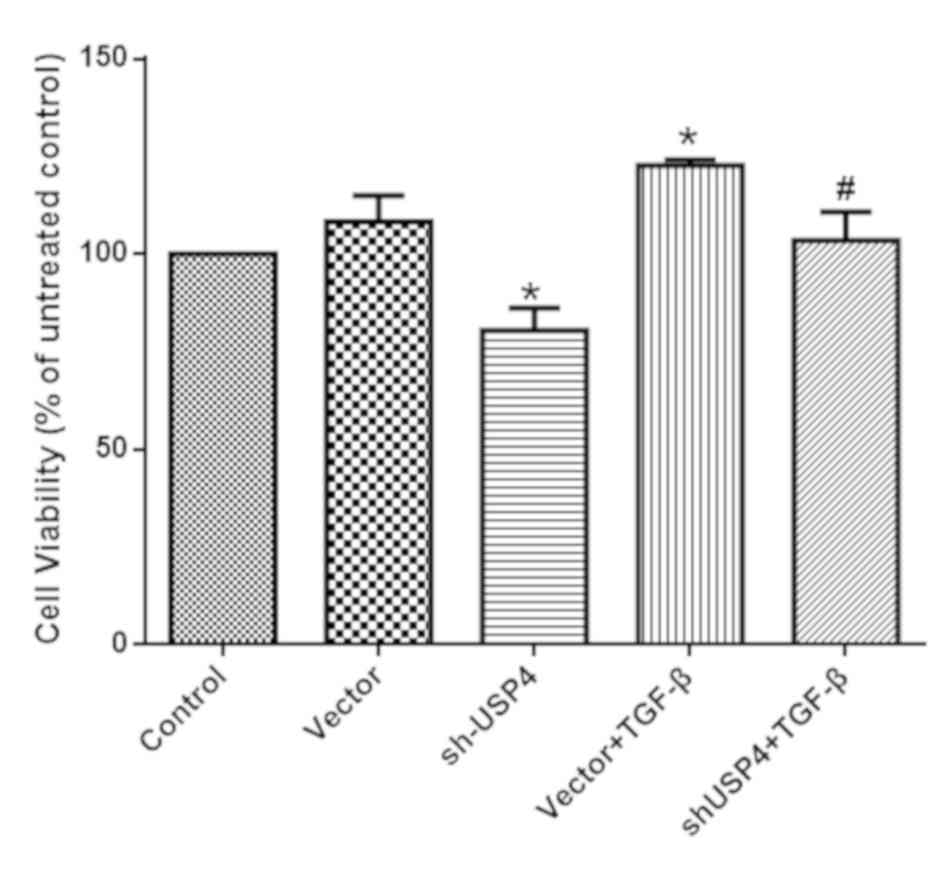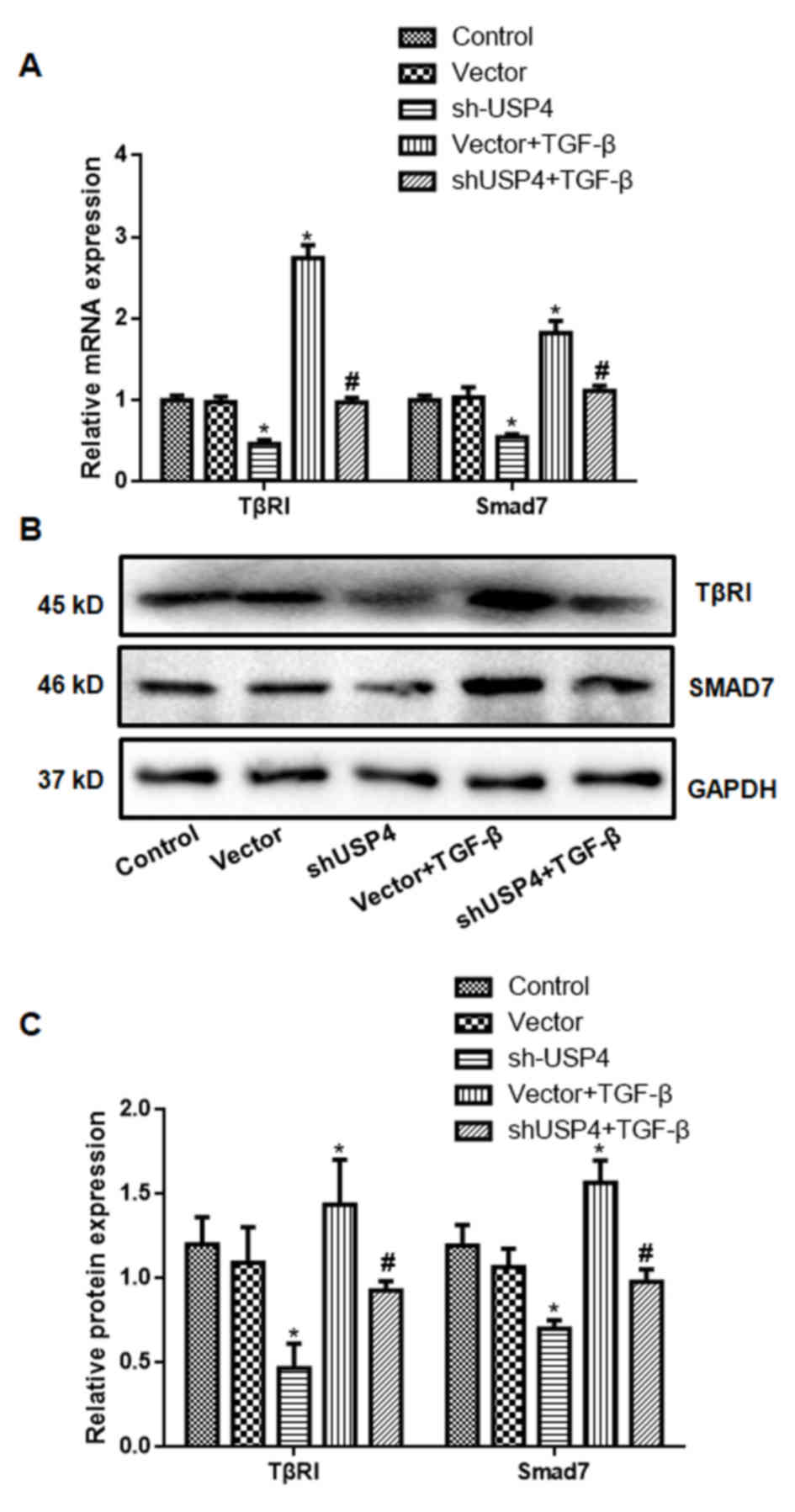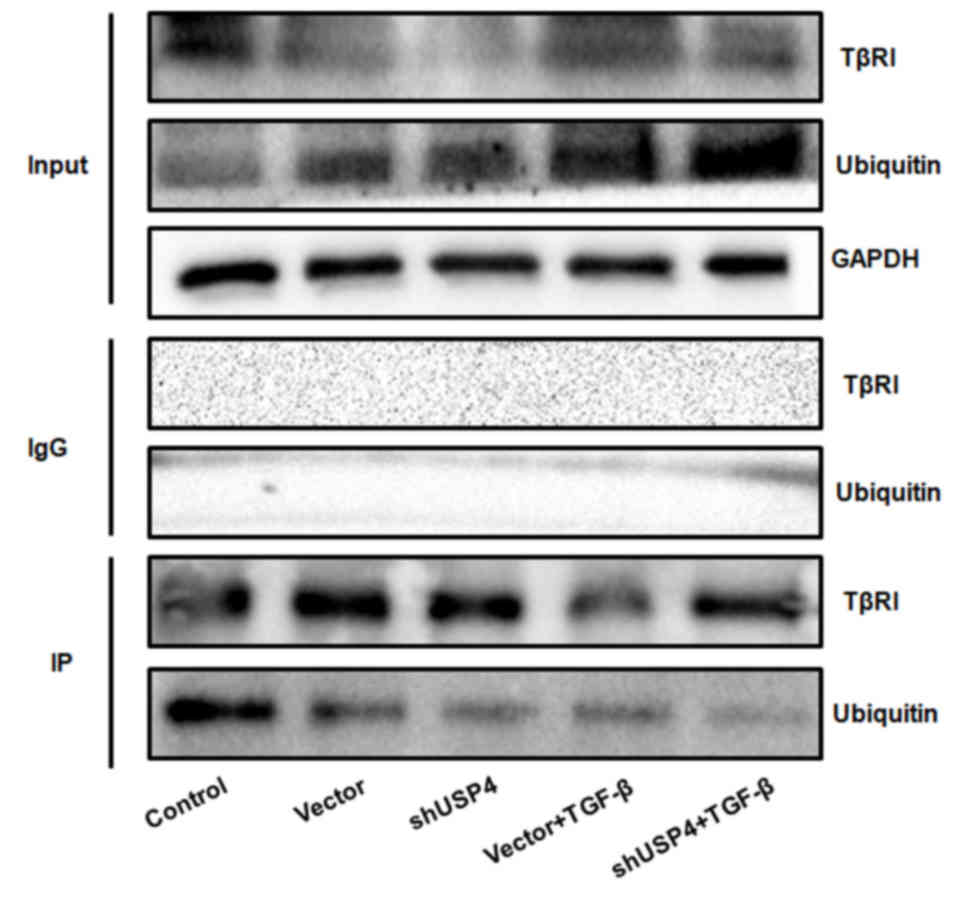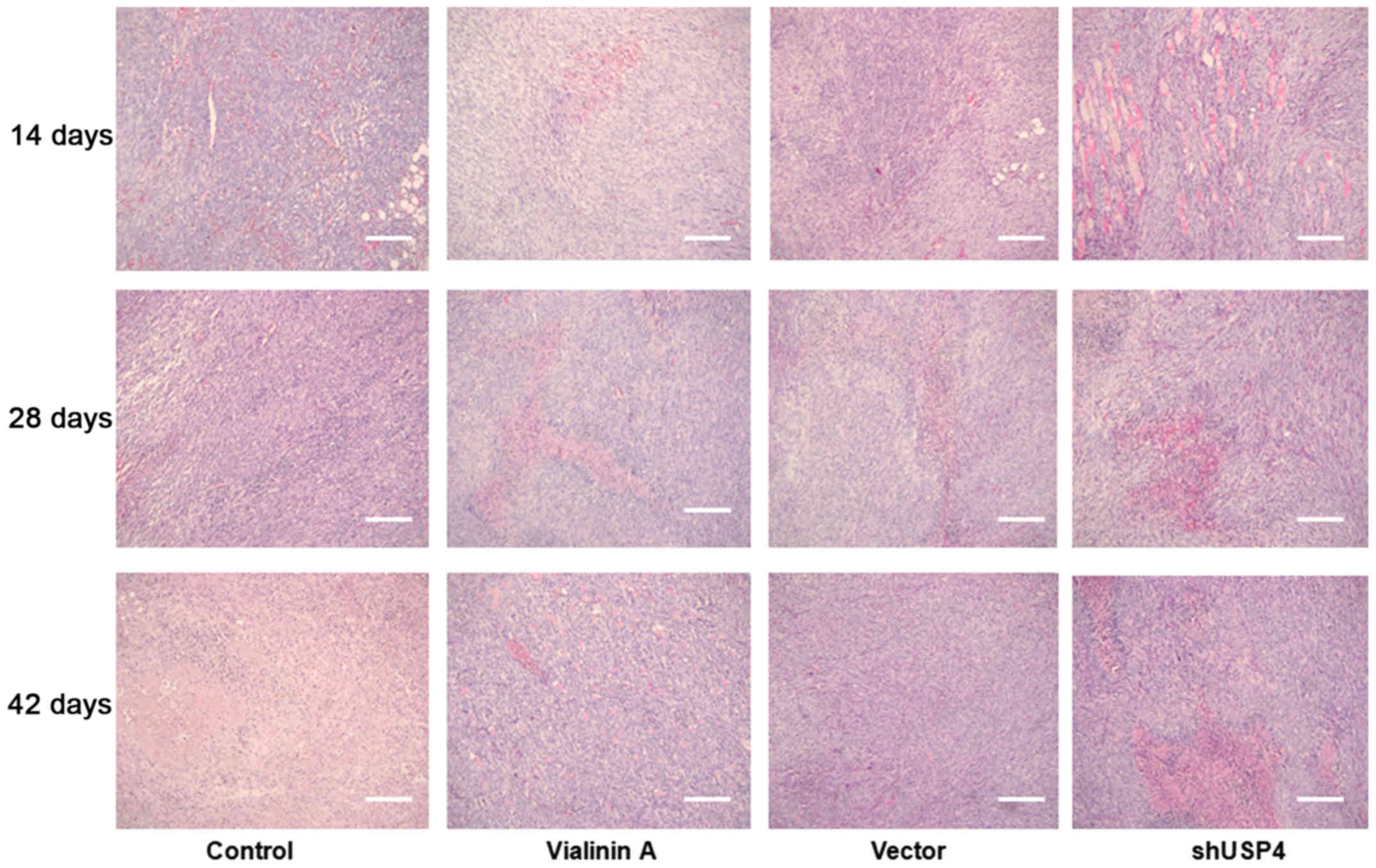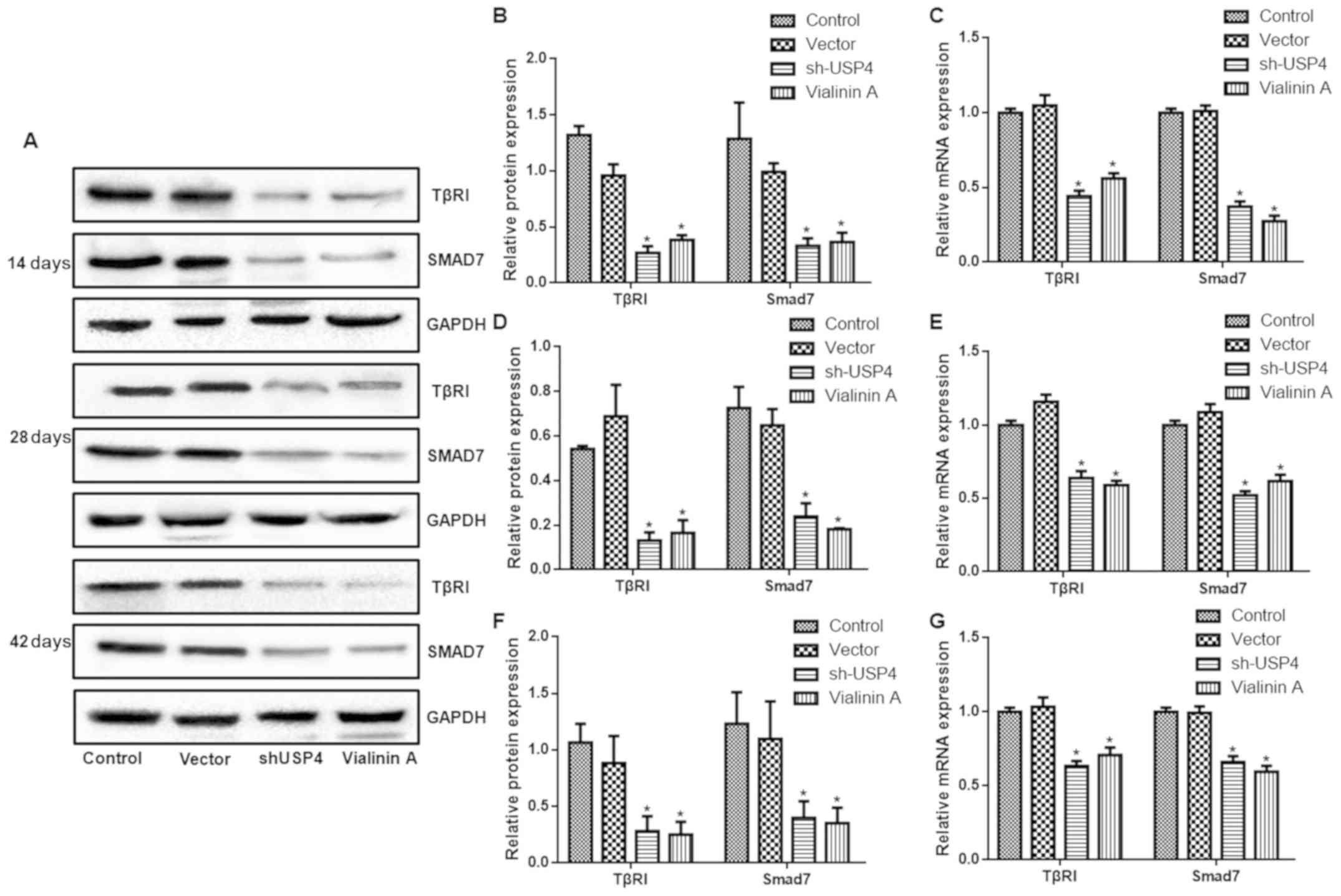Inhibition of USP4 attenuates pathological scarring by downregulation of the TGF‑β/Smad signaling pathway
- Authors:
- Published online on: June 6, 2019 https://doi.org/10.3892/mmr.2019.10370
- Pages: 1429-1435
Abstract
Introduction
Scars are the products of wound healing by the human body. Among them, hypertrophic scars (HS) and keloids are known as pathological scars, which are characterized by sustained hyperactive growth, irregular scar shape, and an uneven and tough texture (1). Pathological scars are the result of hypertrophy of scar tissue in the process of tissue repair following trauma. Pathological scars have serious aesthetic effects and result in tissue dysfunction due to deformities of the scar contractures, particularly at the joints. Certain patients experience pain, itching, ulceration and the development of cancerous cells (2,3). Although pathological scars are recognized as harmful, their etiology and pathogenesis are not fully understood.
Ubiquitin-specific protease 4 (USP4), also known as UnpEL or Unph, is encoded by the proto-oncogene USP4. As an important member of the deubiquitinase family, USP4 was initially reported to bind to the tumor suppressor retinoblastoma, and associated pocket proteins retinoblastoma-like protein 1, retinoblastoma-like protein 2 and E3 ubiquitin (4). It has been hypothesized that USP4 and E3 ubiquitin-protein ligase TRIM21 may regulate their substrates by forming heterodimers via ubiquitination/deubiquitination pathways (5). The transforming growth factor-β (TGF-β) superfamily members are important functional biological molecules (6). TGF-β is closely associated with extracellular matrix deposition, fibrosis and wound healing, which promotes formation of pathological scars (7).
Smads are intracellular molecules of the TGF-β signal transduction pathway (8). TGF-β activates the pathway through membrane receptors TGF-β receptor I (TβRI) and TβRII, which rapidly phosphorylate Smad proteins activating C-terminal serine residues, forming heterologous complexes that in turn activate the transcription of target nuclear genes (9,10). USP4 has been reported to directly deubiquitylate TβRI (11). However, the mechanisms regarding USP4-TβRI in pathological scarring are not completely clear. In the present study, the role of USP4 in the formation of pathological scars in BALB/c nude mice inoculated with keloid cells was examined. In addition, the specific molecular mechanism by which USP4 regulates pathological scar formation was assessed.
Materials and methods
Construction of a USP4 lentiviral interference vector
Based on data from the National Center for Biotechnology Information, 3 short hairpin RHA (shRNA) sequences were designed by Santa Cruz (Santa Cruz Biotechnology, Inc.) (Table I).
Annealing conditions were as follows: Pre-denaturation at 95°C for 5 min, 85°C for 5 min, 75°C for 5 min and 70°C for 5 min, and then maintenance at 4°C. The annealing product (1 µl) was diluted 200-fold and the final concentration was 4.4 ng/l, which was used for subsequent reactions. At 37°C, a PLVshRNA-EGFP (2A) Puro vector (VL3103; Beijing Yingmao Shengye Biotechnology Co., Ltd.) was digested by BamH I/EcoRI and subjected to 1% agarose gel electrophoresis. The 7,861 bp fragments were collected. Lentiviruses encoding shUSP4 were established as described previously (12).
Cell transfection
Human keloid fibroblasts (KFs) were purchased from the American Type Culture Collection (cat. no. CRL-1762) and cultured in Dulbecco's modified Eagle's medium (DMEM; Gibco; Thermo Fisher Scientific, Inc.) supplemented with 10% fetal bovine serum (FBS; Biological Industries) and 100 U/ml penicillin-streptomycin (P1400; Beijing Solarbio Science & Technology, Co., Ltd.) in 5% CO2 at 37°C. Cells at 80% confluence were transfected with the aforementioned lentiviruses (Shanghai GenePharma Co. Ltd.) encoding USP4 shRNA (1×106 IFU/PFU/ml) using Lipofectamine® 2000 (Invitrogen; Thermo Fisher Scientific, Inc.). After 6 h, the medium was replaced with fresh DMEM medium containing 10% FBS and cells cultured in a 5% CO2 incubator at 37°C for 24 h. Experiments were performed 48 h after transfection. Expression of USP4 was verified by reverse transcription-quantitative polymerase chain reaction (RT-qPCR). The experimental groups were as follows: Control; shUSP4; vector; vector + TGF-β (48 h after transfection, 10 ng/ml TGF-β was applied for an additional 48 h); and shUSP4 +TGF-β (48 h after transfection, 10 ng/ml TGF-β was applied for an additional 48 h).
MTT assay
Following treatment, the cells (3×105/ml) were digested and suspended in 96-well plates. The cell numbers at 0 and 48 h were assessed by an MTT assay. MTT (50 µl) was added to each well, and the cells cultured at 37°C for 4 h in a 5% CO2 incubator. After 4 h incubation, supernatants were discarded and dimethyl sulfoxide (150 µl) added to each well to dissolve the formazan. Absorption was measured at 550 nm with an enzyme labeling instrument.
Reverse transcription quantitative polymerase chain reaction (RT-qPCR)
Following transfection and treatment for 48 h, mRNA from the different treatment groups was extracted using a TRIzol assay kit (Baosheng Science & Technology Innovation, Co. Ltd.). mRNA was transcribed into cDNA using a reverse transcription kit (cat. no. 639522, Takara Biotechnology Co., Ltd.) at 37°C using the following thermocycler conditions: 25°C for 10 min, 37°C for 120 min and 85°C for 5 min. RT-qPCR was used to detect the expression level of the target genes with SYBR Green (HY-K0501; MedChemExpress). The thermocycling conditions were as follows: Initial denaturation at 95°C for 10 min, followed by 40 cycles of PCR at 95°C for 10 sec, 60.3°C for 30 sec and 72°C for 30 sec. The 2−ΔΔCq method was used to quantify the results as previously described (13,14). The primers (5′-3′) used are listed in Table II.
Immunoprecipitation (IP)
IP experiments were performed using a Pierce Crosslink IP kit (Thermo Fisher Scientific, Inc.). As described in the manufacturer's instructions, the cells of different groups were homogenized in IP lysis/wash buffer containing proteasome inhibitor MG-132 (10 mM; Sigma-Aldrich; Merck KGaA) and complete EDTA-free Protease Inhibitor Cocktail (Sigma-Aldrich; Merck KGaA). The supernatants were collected after centrifugation at 15,000 × g for 10 min at 4°C. Samples (2 mg) were added to anti-ubiquitin antibody-cross-linked Protein A/G Plus Agarose, and then incubated at 4°C overnight. Following incubation, nonspecific binding was eliminated by repeated washing with IP lysis/wash buffer. Eluted IP products were used for western blot analysis to detect ubiquitinated TRβI with an anti-TrβI antibody (1:1,000; cat. no. ab92486; Abcam).
Western blot analysis
Following transfection and treatment for 48 h, proteins were extracted from cell lines for western blot analysis using a ReadyPrep protein isolation kit (GE Healthcare Life Sciences) as described previously (15). Protein levels were quantified with a bicinchoninic acid protein assay kit. Proteins (25 µg/lane) were separated via 12% SDS-PAGE and transferred onto nitrocellulose membranes. The membranes were blocked with 5% skim milk for 2 h at room temperature and incubated with the following primary antibodies overnight at 4°C: Anti-TRβI (1:1,000; cat. no. ab92486; Abcam); and anti-Smad7 (1:1,000; cat. no., ab190987; Abcam). The anti-rabbit IgG horseradish peroxidase-conjugated secondary antibody (1:100; cat. no. ab131368; Abcam) was added and incubated with the membranes for 2 h at room temperature. An enhanced chemiluminescence reagent (cat. no. RPN2133; GE Healthcare Life Sciences) was added to the membranes. The membranes were visualized using a gel imaging system (Bio-Rad Laboratories, Inc.). Densitometry was performed using Quantity One v1.4.6 (Bio-Rad Laboratories, Inc.). Experiments were repeated 3 times.
Establishment of an in vivo tumor model
All animal experiments were approved by the Ethics Committee of Nanchang University (Nanchang, China). A total of 24 male BALB/c nude mice (4-week-old) were purchased from Hunan Shanghai Laboratory Animal Center, Jingda Laboratory Animal Co., Ltd., License No. SCXK 2016-0002) and housed in specific pathogen-free conditions that were automatically maintained at a temperature of 23±2°C, a relative humidity of 45–65%, and with a controlled 12 h light/dark cycle. Mice implanted with the tumor cell lines were randomly divided into four groups (n=5 in each group): A control cell group; a control cells + vialinin A (USP inhibitor, HY-13814, MedChemExpress LLC) group; a shUSP4-transfected cell group; and a vector transfected cell group. Animals were injected with KFs in the logarithmic growth phase (1×106). For the control group, KFs were diluted in 0.2 ml PBS and administrated through subcutaneous injection into the nude mice. For the vector control group, KFs transfected with control vector were diluted in 0.2 ml PBS and injected. For the shUSP4 group, KFs transfected with viral USP4 shRNA were diluted in 0.2 ml PBS and injected. For the control cells + vialinin A group, KFs were treated with vialinin A (5 µM, 48 h) and diluted in 0.2 ml PBS and injected. For the shUSP4 group, KFs transfected with viral USP4 shRNA (Santa Cruz Biotechnology, Inc.) were diluted in 0.2 ml PBS and injected. The nude mice were sacrificed at 14, 28 and 42 days after inoculation. All animals presented with a single subcutaneous tumor in the forelimb armpit and the longest diameter was <8 mm. Following complete anesthesia with 5% isoflurane, the tumors were excised and stored at −80°C for western blot analysis, RT-qPCR, and fixed with 10% formalin overnight at 4°C for hematoxylin and eosin staining.
Hematoxylin and eosin (H&E) staining
The tissues were then embedded in paraffin for tissue sectioning and sectioned into 5 µm-thick sections. Then, the sections were stained with hematoxylin (3%) and eosin (3%) at room temperature for 3 min and observed by light microscopy (magnification, ×200, BX51, Olympus Corporation).
Statistical analysis
Data are presented as mean ± standard error of the mean. Analyses were performed using SPSS version 19.0 (IBM Corp.). Significant differences were determined using one-way analysis of variance followed by the Student-Newman-Keuls post-hoc test. P<0.05 was considered to indicate a statistically significant difference.
Results
Confirmation of USP4 silencing
As demonstrated in Fig. 1, 3 interference sequences for shUSP4 were designed, with shUSP4-2 producing a significant interference effect. Therefore, shUSP4-2 was selected for subsequent experiments.
shUSP4 decreases cell viability
As presented in Fig. 2, the cell viability of the shUSP4 group was significantly decreased compared with the control group. By contrast, TGF-β incubation significantly increased cell viability, which was decreased by shUSP4 interference (P<0.05). These data suggest that USP4 silencing decreased the proliferation of KFs in the negative control, following TGF-β-treatment.
shUSP4 decreases TβRI and Smad7 expression
The expression levels of TβRI and Smad7 for each group are indicated in Fig. 3. Compared with the control group, the expression of TβRI and Smad7 by the shUSP4 group was significantly decreased, while the expression levels of TβRI and Smad7 in the Vector + TGF-β group was significantly increased; this was attenuated by shUSP4 (P<0.05). As demonstrated by the IP analysis data, ubiquitination of TβRI was identified in each group (Fig. 4), indicating a direct correlation of TβRI with ubiquitin.
shUSP4 facilitates necrotic death of tumor tissue and decreases the expression of TβRI and Smad7
As demonstrated in Fig. 5, at day 14 there was no remarkable difference in the histological structures of the KF among the groups. At days 28 and 42, marked necrotic scarring was observed in the shUSP4 and vialinin A groups compared with the control group.
As presented in Fig. 6, the expression levels of TβRI and Smad7 in the shUSP4 and vialinin A groups were significantly decreased compared with those of the control group at days 14, 28 and 42 (P<0.05).
Discussion
To the best of our knowledge, the present study is the first to demonstrate that silencing or inhibition of USP4 prevented the TGF-β/Smad signaling pathway, which inhibited the formation of pathological scars. USP4 may bind TβRI to inhibit the Smad7-mediated signaling pathway, preventing the ubiquitination of TβRI, which maintains a high level of TβRI and sustained stimulation of TGF-β in tissues of the skin.
The localization and stability of TβRI determines the activity of the TGF-β signaling pathway (16), while the Smad7/Smurf 2 complex targets and degrades TβRI through the ubiquitination pathway (17). Using genome-wide functional screening, Zhang et al (11) identified that USP4 enhanced the TGF-β signaling pathway. USP4 interacts directly with TβRI and inhibits its ubiquitination pathway, thereby maintaining a high level of TβRI at the cell membrane surface (11). Removal of USP4 attenuates the process of epithelial mesenchymal transition mediated by the TGF-β pathway (11). In the present study, cellular and animal experiments revealed that the expression of TβRI and Smad7 decreased following USP4 silencing, which indicated that USP4 affected the TGF-β signaling pathway. The tumorigenesis experiment demonstrated that USP4 inhibition improved pathological scarring. These results suggested that USP4 may serve a regulatory role in the formation of pathological scars by regulating the TGF-β signaling pathway.
USP4 is also involved in the negative regulation of the Wnt signaling pathway (18), deubiquitination of adenosine A2a (19) and regulation of the cell cycle (20). Zhang et al (21) identified that USP4 enhanced its stability by ubiquitinating E3 ubiquitin-protein ligase HUWE1, in turn downregulating P53 expression. Fan et al (22) reported that USP4 downregulated TNF-α-induced NF-κB activation by deubiquitinating mitogen-activated protein kinase kinase kinase 7. In the present study, following the downregulation of USP4, the ubiquitination level of TβRI was markedly decreased and pathological scarring improved. These results imply an association between pathological scarring and the ubiquitination level of TβRI.
The TGF-β/Smad pathway serves a major regulatory role in the formation of pathological scar formation (23,24). The expression of TGF-β1, TGF-β2 and TβRI in keloid keratinocytes was increased compared with that of normal skin, suggesting an association between TGF-β1, TGF-β2 and TβRI in KFs. Fibroblasts have been induced to express more TGF-β1 and TGF-β2 by paracrine action (25). The expression levels of TGF-β1/Smad3 differ during stages of human growth and development; TGF-β/Smad3 are not expressed at all during the fetal period. This may, in part, explain the mechanistic basis for the presence of scarless wounds during the fetal period (26,27). Chin et al (28) demonstrated that the expression levels of TβRI and Smad3 proteins in KFs were significantly increased compared with normal skin, indicating that these proteins exhibited positive feedback effects on the TGF-β/Smad pathway, promoting the formation of keloids.
Bock et al (29) revealed that in KFs, the expression of TβRI was high and the expression of TβRII was low, and that the proliferation of KF was enhanced when stimulated with TGF-β1. Goldberg et al (30) suggested that the overexpression of TβRII inhibited the proliferation of fibroblasts. Bran et al (31) also demonstrated that the expression levels of TGF-β1 and TGF-β2 in cultured KFs were increased compared with that in normal fibroblasts, while the expression of TβRII was significantly decreased compared with that in normal fibroblasts. The TGF-β/Smad signal transduction pathway affects the healing process (32). This pathway functions at multiple levels, from the release of early inflammatory mediators, to wound healing, to subsequent pathological scarring (33).
The results of the in vitro and animal experiments suggest that the inhibition of the TGF-β/Smad signaling pathway may effectively decrease the deposition of extracellular matrix, and the levels of tissue fibrosis and pathological scarring during wound healing (34). Ubiquitination is a prominent strategy for post-translational modification, which regulates a number of biological functions, including: Cell cycle; apoptosis; DNA damage repair; cellular immunity; and neuronal degeneration (35–37). The results of the present study demonstrate that ubiquitin had a direct association with TβRI, which in turn regulated downstream signal transduction and pathological scarring.
There were several limitations of the present study. Firstly, to the best of our knowledge, the study was the first to use an in vivo xenograft tumor model to examine pathological scarring. The similarity between these in vitro and in vivo experiments requires further confirmation. Secondly, whether USP4 may be a target for the treatment of pathological scarring requires additional pharmacological data.
In summary, the inhibition of USP4 attenuates the TGF-β/Smad signaling pathway and decreases the formation of pathological scars. The present study provides the foundation for a novel method to prevent and treat pathological scars of the skin.
Acknowledgements
Not applicable.
Funding
The present study was supported by the National Natural Science Foundation of China (grant nos. 81460295 and 81660322) and Jiangxi Provincial Science Foundation for Distinguished Young Scholars (grant no. 20171BCB23090).
Availability of data and materials
The datasets used and/or analyzed during the present study are available from the corresponding author on reasonable request.
Authors' contributions
JZ, SN, SP, SL, YX, QJ, ZL, JY and ZC performed the experiments and analyzed the data. JZ and ZC designed the study and wrote the manuscript.
Ethics approval and consent to participate
All animal experiments were approved by the Ethics Committee of Nanchang University (Nanchang, China).
Patient consent for publication
Not applicable.
Competing interests
The authors declare that they have no competing interests.
References
|
Song H, Tan J, Fu Q, Huang L and Ao M: Comparative efficacy of intralesional triamcinolone acetonide injection during early and static stage of pathological scarring. J Cosmet Dermatol. Jun 22–2018.(Epub ahead of print). | |
|
Liao N, Lu F, Zhao W, Zeng WS, Li YT, Wang SJ and Gao JH: Relationship between gene p53 codon 72 polymorphism and pathological scar formation after caesarean section. Zhonghua Zheng Xing Wai Ke Za Zhi. 29:206–210. 2013.(In Chinese). PubMed/NCBI | |
|
Wu WY, Zhang LT, Zheng ZF, Zhu SZ and Wang ZY: Expression and significance of mRNA and protein of eIF4E, p-eIF4E and MCl-1 in pathological scar. Zhonghua Zheng Xing Wai Ke Za Zhi. 28:360–365. 2012.(In Chinese). PubMed/NCBI | |
|
DeSalle LM, Latres E, Lin D, Graner E, Montagnoli A, Baker RT, Pagano M and Loda M: The de-ubiquitinating enzyme Unp interacts with the retinoblastoma protein. Oncogene. 20:5538–5542. 2001. View Article : Google Scholar : PubMed/NCBI | |
|
Wada K and Kamitani T: UnpEL/Usp4 is ubiquitinated by Ro52 and deubiquitinated by itself. Biochem Biophys Res Commun. 342:253–258. 2006. View Article : Google Scholar : PubMed/NCBI | |
|
Yan X, Liao H, Cheng M, Shi X, Lin X, Feng XH and Chen YG: Smad7 protein interacts with receptor-regulated Smads (R-Smads) to inhibit transforming growth factor-β (TGF-β)/Smad signaling. J Biol Chem. 291:382–392. 2016. View Article : Google Scholar : PubMed/NCBI | |
|
Dong X, Zhao B, Iacob RE, Zhu J, Koksal AC, Lu C, Engen JR and Springer TA: Force interacts with macromolecular structure in activation of TGF-β. Nature. 542:55–59. 2017. View Article : Google Scholar : PubMed/NCBI | |
|
Sun Q, Guo S, Wang CC, Sun X, Wang D, Xu N, Jin SF and Li KZ: Cross-talk between TGF-β/Smad pathway and Wnt/β-catenin pathway in pathological scar formation. Int J Clin Exp Pathol. 8:7631–7639. 2015.PubMed/NCBI | |
|
Beanes SR, Dang C, Soo C and Ting K: Skin repair and scar formation: The central role of TGF-beta. Exp Rev Mol Med. 5:1–22. 2003. View Article : Google Scholar | |
|
Penn JW, Grobbelaar AO and Rolfe KJ: The role of the TGF-β family in wound healing, burns and scarring: A review. Int J Burns Trauma. 2:18–28. 2012.PubMed/NCBI | |
|
Zhang L, Zhou F, Drabsch Y, Gao R, Snaar-Jagalska BE, Mickanin C, Huang H, Sheppard KA, Porter JA, Lu CX and ten Dijke P: USP4 is regulated by AKT phosphorylation and directly deubiquitylates TGF-β type I receptor. Nat Cell Biol. 14:717–726. 2012. View Article : Google Scholar : PubMed/NCBI | |
|
Li W, Tao S, Wu Q, Wu T, Tao R and Fan J: Glutamine reduces myocardial cell apoptosis in a rat model of sepsis by promoting expression of heat shock protein 90. J Surg Res. 220:247–254. 2017. View Article : Google Scholar : PubMed/NCBI | |
|
Livak KJ and Schmittgen TD: Analysis of relative gene expression data using real-time quantitative PCR and the 2(-Delta Delta C(T)) method. Methods. 25:402–408. 2001. View Article : Google Scholar : PubMed/NCBI | |
|
Zhu G, Li J, He L, Wang X and Hong X: MPTP-induced changes in hippocampal synaptic plasticity and memory are prevented by memantine through the BDNF-TrkB pathway. Br J Pharmacol. 172:2354–2368. 2015. View Article : Google Scholar : PubMed/NCBI | |
|
Song Z, Chen H, Xu W, Wu S and Zhu G: Basolateral amygdala calpain is required for extinction of contextual fear-memory. Neurobiol Learn Mem. 155:180–188. 2018. View Article : Google Scholar : PubMed/NCBI | |
|
Xiong G, Huang Z, Jiang H, Pan Z, Xie J and Wang S: Inhibition of microRNA-21 decreases the invasiveness of fibroblast-like synoviocytes in rheumatoid arthritis via TGFβ/Smads signaling pathway. Iran J Basic Med Sci. 19:787–793. 2016.PubMed/NCBI | |
|
Xu X, Xu C, Saud SM, Lu X, Liu L, Fang L, Zhang X, Hu J and Li W: Effect of kuijie granule on the expression of TGF-β/Smads signaling pathway in patients with ulcerative colitis. Evid Based Complement Alternat Med. 2016:26018302016. View Article : Google Scholar : PubMed/NCBI | |
|
Zhao B, Schlesiger C, Masucci MG and Lindsten K: The ubiquitin specific protease 4 (USP4) is a new player in the Wnt signalling pathway. J Cell Mol Med. 13:1886–1895. 2009. View Article : Google Scholar : PubMed/NCBI | |
|
Milojevic T, Reiterer V, Stefan E, Korkhov VM, Dorostkar MM, Ducza E, Ogris E, Boehm S, Freissmuth M and Nanoff C: The ubiquitin-specific protease Usp4 regulates the cell surface level of the A2A receptor. Mol Pharmacol. 69:1083–1094. 2006. View Article : Google Scholar : PubMed/NCBI | |
|
Wijnhoven P, Konietzny R, Blackford AN, Travers J, Kessler BM, Nishi R and Jackson SP: USP4 auto-deubiquitylation promotes homologous recombination. Mol Cell. 60:362–373. 2015. View Article : Google Scholar : PubMed/NCBI | |
|
Zhang X, Berger FG, Yang J and Lu X: USP4 inhibits p53 through deubiquitinating and stabilizing ARF-BP1. EMBO J. 30:2177–2189. 2011. View Article : Google Scholar : PubMed/NCBI | |
|
Fan YH, Yu Y, Mao RF, Tan XJ, Xu GF, Zhang H, Lu XB, Fu SB and Yang J: USP4 targets TAK1 to downregulate TNFα-induced NF-κB activation. Cell Death Differ. 18:1547–1560. 2011. View Article : Google Scholar : PubMed/NCBI | |
|
Wang Y, Zhang L, Lei R, Shen Y, Shen H, Wu Z and Xu J: Effects of blocking two sites of transforming growth factor-β/Smads signaling on the formation of scar-related proteins in human skin fibroblasts. Zhonghua Shao Shang Za Zhi. 31:372–377. 2015.(In Chinese). PubMed/NCBI | |
|
Nong Q, Li S, Wu Y and Liu D: LncRNA COL1A2-AS1 inhibits the scar fibroblasts proliferation via regulating miR-21/Smad7 pathway. Biochem Biophys Res Commun. 495:319–324. 2018. View Article : Google Scholar : PubMed/NCBI | |
|
Xia W, Phan TT, Lim IJ, Longaker MT and Yang GP: Complex epithelial-mesenchymal interactions modulate transforming growth factor-beta expression in keloid-derived cells. Wound Repair Regen. 12:546–556. 2004. View Article : Google Scholar : PubMed/NCBI | |
|
Emami A, Halim AS, Salahshourifar I, Yussof SJ, Khoo TL and Kannan TP: Association of TGFβ1 and SMAD4 variants in the etiology of keloid scar in the Malay population. Arch Dermatol Res. 304:541–547. 2012. View Article : Google Scholar : PubMed/NCBI | |
|
Ward SV, Cadby G, Heyworth JS, Fear MW, Wallace HJ, Cole JM, Wood FM and Palmer LJ: Association of TGFβ1 and clinical factors with scar outcome following melanoma excision. Arch Dermatol Res. 304:343–351. 2012. View Article : Google Scholar : PubMed/NCBI | |
|
Chin GS, Liu W, Peled Z, Lee TY, Steinbrech DS, Hsu M and Longaker MT: Differential expression of transforming growth factor-beta receptors I and II and activation of Smad 3 in keloid fibroblasts. Plast Reconstr Surg. 108:423–429. 2001. View Article : Google Scholar : PubMed/NCBI | |
|
Bock O, Yu H, Zitron S, Bayat A, Ferguson MW and Mrowietz U: Studies of transforming growth factors beta 1–3 and their receptors I and II in fibroblast of keloids and hypertrophic scars. Acta Derm Venereol. 85:216–220. 2005.PubMed/NCBI | |
|
Goldberg HJ, Huszár T, Mózes MM, Rosivall L and Mucsi I: Overexpression of the type II transforming growth factor-beta receptor inhibits fibroblasts proliferation and activates extracellular signal regulated kinase and c-Jun N-terminal kinase. Cell Biol Int. 26:165–174. 2002. View Article : Google Scholar : PubMed/NCBI | |
|
Bran GM, Goessler UR, Schardt C, Hormann K, Riedel F and Sadick H: Effect of the abrogation of TGF-beta1 by antisense oligonucleotides on the expression of TGF-beta-isoforms and their receptors I and II in isolated fibroblasts from keloid scars. Int J Mol Med. 25:915–921. 2010. View Article : Google Scholar : PubMed/NCBI | |
|
Li SC, Ma LN, Chen J and Li YK: Effect of allicin on myocardial fibrosis after myocardial infarction in rats and its relationship with TGFβ/Smads signal transduction. Zhongguo Zhong Yao Za Zhi. 41:2517–2521. 2016.(In Chinese). PubMed/NCBI | |
|
Hu ZC, Shi F, Liu P, Zhang J, Guo D, Cao XL, Chen CF, Qu SQ, Zhu JY and Tang B: TIEG1 Represses Smad7-mediated activation of TGF-β1/Smad signaling in keloid pathogenesis. J Invest Dermatol. 137:1051–1059. 2017. View Article : Google Scholar : PubMed/NCBI | |
|
D'Arpino MC, Fuchs AG, Sánchez SS and Honoré SM: Extracellular matrix remodeling and TGF-β1/Smad signaling in diabetic colon mucosa. Cell Biol Int. 42:443–456. 2018. View Article : Google Scholar : PubMed/NCBI | |
|
Popovic D, Vucic D and Dikic I: Ubiquitination in disease pathogenesis and treatment. Nat Med. 20:1242–1253. 2014. View Article : Google Scholar : PubMed/NCBI | |
|
Wu Y, Kang J, Zhang L, Liang Z, Tang X, Yan Y, Qian H, Zhang X, Xu W and Mao F: Ubiquitination regulation of inflammatory responses through NF-κB pathway. Am J Transl Res. 10:881–891. 2018.PubMed/NCBI | |
|
Cheng YF, Zhu GQ, Wang M, Cheng H, Zhou A, Wang N, Fang N, Wang XC, Xiao XQ, Chen ZW and Li QL: Involvement of ubiquitin proteasome system in protective mechanisms of Puerarin to MPP(+)-elicited apoptosis. Neurosci Res. 63:52–58. 2009. View Article : Google Scholar : PubMed/NCBI |



